Summary Overview
Castor Oil Market Overview
The global castor oil market is projected to grow from USD 1.2 billion in 2024 to USD 1.68 billion by 2032, reflecting a compound annual growth rate (CAGR) of 5.3%. This growth is primarily driven by the increasing demand for castor oil in various industries such as biodiesel production, cosmetics, pharmaceuticals, and manufacturing of lubricants, paints, and coatings. The market is also benefiting from growing awareness of its health benefits and expanding applications in bioplastics.
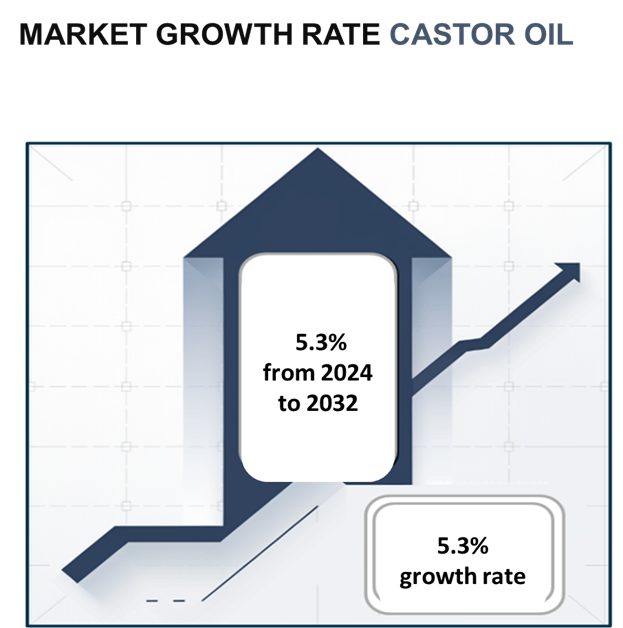
Growth Rate: 5.3% CAGR
Sector Contributions:
-
Biodiesel Industry: A significant driver due to the increasing demand for renewable energy sources. -
Cosmetics & Pharmaceuticals: Castor oil is increasingly used in hair care, skin care products, and medications due to its medicinal and therapeutic properties. -
Plastics & Lubricants: Usage of castor oil-based products in the production of bioplastics and lubricants is growing.
Technological Transformation and Innovations:
-
Improved Cultivation Techniques: Genetic improvements in castor plant varieties and advancements in oil extraction methods are driving efficiency. -
Sustainable Production: Growing emphasis on the sustainability of castor oil production processes, such as organic and eco-friendly farming practices.
Funding Initiatives:
- Increased investments in research and development for expanding applications of castor oil in bioplastics, biodiesel, and personal care.
Regional Insights:
-
India remains the leading producer and exporter of castor oil, with major markets in China, the United States, and Europe. -
Asia-Pacific is expected to remain the dominant region in production and consumption, driven by the expanding industrial base and demand for sustainable products.
Key Trends and Sustainability Outlook:
-
Sustainability Initiatives: Focus on reducing the environmental impact of castor oil production, with advancements in eco-friendly farming and processing techniques. -
Health and Beauty Trends: Rising consumer demand for plant-based and organic cosmetic products has contributed significantly to market growth. -
Biofuels and Bioplastics: A growing application in biofuels, particularly biodiesel, and eco-friendly plastics, driven by global sustainability goals.
Growth Drivers:
-
Health Benefits: Castor oil's medicinal properties, including its anti-inflammatory and moisturizing effects, are driving its increasing use in the healthcare and beauty industries. -
Global Population Growth: Expanding demand for natural oils in food, personal care, and industrial applications. -
Rising Demand for Renewable Energy: The increasing adoption of biodiesel as a renewable fuel is bolstering demand for castor oil as a raw material. -
Eco-Friendly Products: The push for biodegradable plastics and other green technologies is driving castor oil's adoption.
Overview of Market Intelligence Services for Castor Oil Market
Market intelligence tools and reports provide comprehensive insights into pricing trends, supply chain management, and procurement strategies. Given the volatility in castor oil prices, largely due to climatic factors and fluctuating supply from key regions like India, procurement managers rely on detailed market forecasts and risk assessments to navigate challenges. Stakeholders are encouraged to adopt strategic sourcing practices and leverage digital procurement tools to ensure the stability of their supply chains while optimizing costs.
Procurement Intelligence for Castor Oil Market: Category Management and Strategic Sourcing
In the Castor Oil market, companies are increasingly focusing on procurement category management and strategic sourcing to enhance supply chain efficiency and cost-effectiveness. By leveraging spend analysis solutions and vendor spend analysis, stakeholders can optimize procurement strategies, ensuring the timely availability of high-quality castor oil while controlling costs. As castor oil is a vital raw material for industries such as biodiesel production, pharmaceuticals, cosmetics, and lubricants, managing supplier relationships and understanding supply market dynamics is critical.
 Pricing Outlook for Castor Oil Market: Spend Analysis
Pricing Outlook for Castor Oil Market: Spend Analysis
The Castor Oil market is also navigating a complex pricing landscape influenced by various factors, such as climatic conditions, rising demand across multiple industries, and supply chain constraints. These variables are contributing to pricing fluctuations, and projections for the coming years indicate a steady upward trend in castor oil prices.
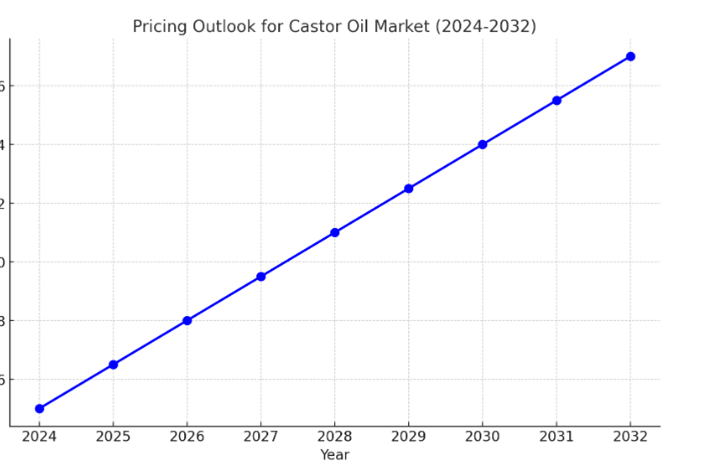
The line chart illustrating the projected pricing outlook for the Castor Oil market from 2024 to 2032.
Several key factors are driving these price shifts
-
Rising Production Costs: The cost of production has been affected by factors like rising labour costs, water scarcity, and the adoption of more sustainable farming practices. Castor oil production relies heavily on specific climatic conditions, and the rising costs of cultivation methods are making it more expensive. -
Increased Demand: There is a surge in demand for castor oil, driven by its applications in various industries, including cosmetics, biofuels, pharmaceuticals, and lubricants. Its growing use in eco-friendly products and bio-based alternatives is boosting global consumption, further pushing up prices. -
Export Opportunities: The expanding markets in Asia, Africa, and Europe are increasing demand and creating competitive pricing pressures. As more countries adopt renewable energy sources and eco-friendly products, castor oil exports are seeing higher demand, contributing to price volatility. -
Climate Impact: Castor oil is primarily sourced from India and Brazil, regions that are vulnerable to changing climatic conditions. Droughts, floods, and other adverse weather events have a direct impact on castor crop yields, which can cause significant fluctuations in supply and, in turn, affect pricing.
Cost Breakdown for the Castor Oil Market : Cost Saving Opportunities
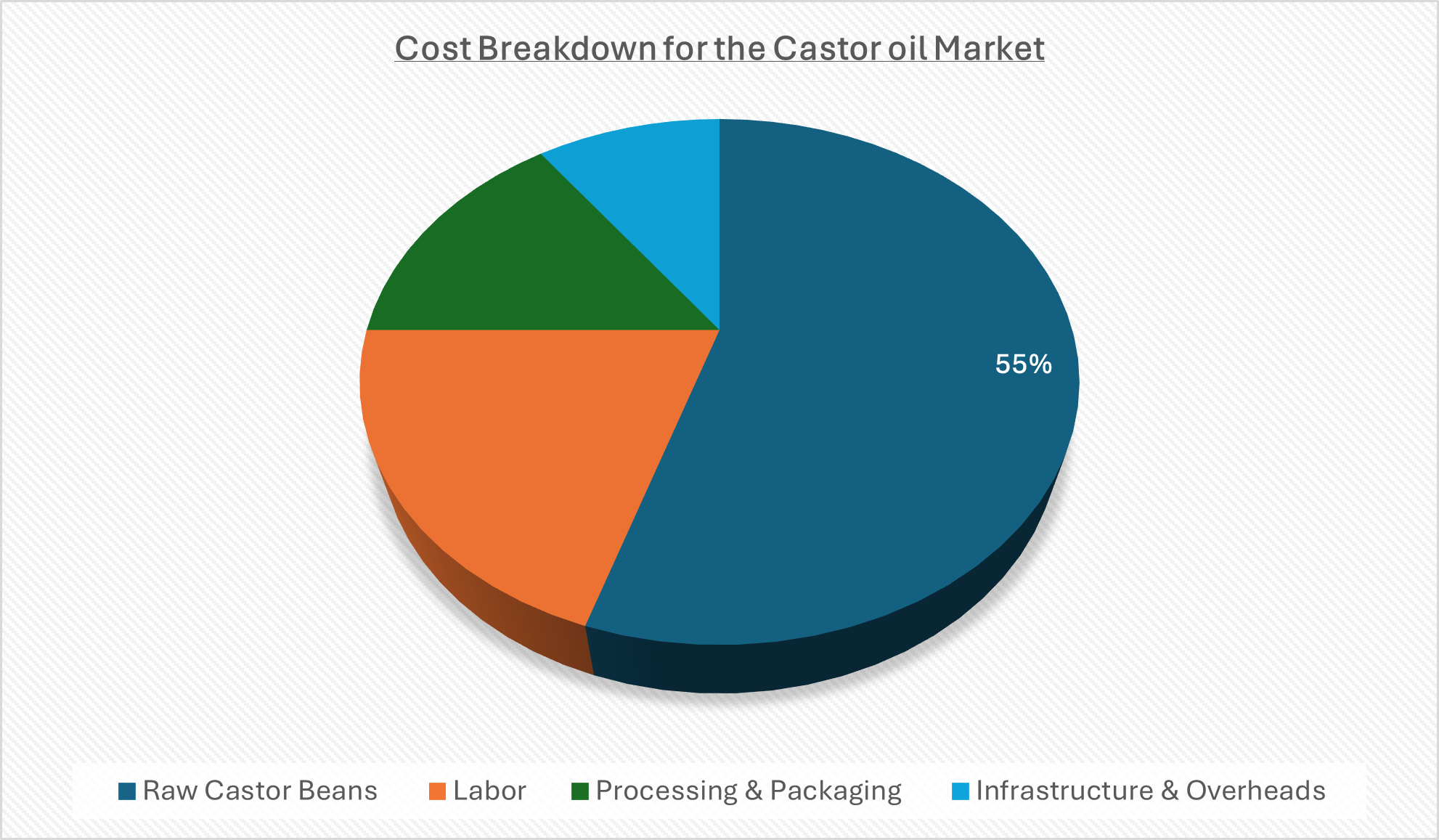
- Raw Castor Beans (55%)
-
Description: Represents the primary raw material cost for producing castor oil. Castor beans are cultivated mainly in countries like India, China, and Brazil, with India being the largest supplier. -
Trends: Prices of castor beans have fluctuated due to supply constraints, weather-related disruptions, and geopolitical factors. As of 2024, prices are expected to increase due to limited supply from major producing countries and rising global demand for castor oil in industries like cosmetics, pharmaceuticals, and lubricants.
- Labor (XX%)
- Processing & Packaging (XX%)
- Transportation & Logistics (XX%)
Cost saving opportunity: Negotiation Lever and Purchasing Negotiation Strategies
In the Castor Oil market, cost-saving strategies include collaborative purchasing for bulk discounts, adopting sustainable farming practices to reduce input costs, and leveraging precision agriculture technologies to optimize resource use. Vertical integration can lower processing costs, while energy-efficient processing facilities cut utility expenses. Optimizing transportation and forming strategic supplier partnerships help reduce logistics and material costs. Additionally, shared marketing efforts through cooperatives allow producers to reduce advertising expenses, improving overall profitability and efficiency.

Supply and Demand Overview of the Castor Oil Market: Demand-Supply Dynamics and Buyer Intelligence for Effective Supplier Relationship Management (SRM)
The Castor Oil market is experiencing robust growth driven by expanding applications in industries such as pharmaceuticals, cosmetics, and biofuels. Demand is particularly strong due to the increasing use of castor oil in beauty and healthcare products, as well as its growing role as a sustainable alternative in industrial applications.
Demand Factors:
-
Cosmetic and Pharmaceutical Applications: The increasing use of castor oil in skin care products, hair care formulations, and pharmaceuticals due to its moisturizing, anti-inflammatory, and medicinal properties is driving demand. -
Biofuel Production: Castor oil is gaining popularity as a renewable biofuel, particularly in the automotive and industrial sectors, as countries look for sustainable energy sources. -
Health Trends: A growing preference for natural and organic products in beauty and healthcare is further propelling the demand for castor oil, especially in the wellness and cosmetic industries. -
Industrial Uses: Castor oil's versatility in lubricants, paints, coatings, and manufacturing of polymers boosts demand in diverse sectors, including manufacturing and automotive.
Supply Factors:
-
India’s Dominance: India is the world’s largest producer of castor oil, accounting for over 70% of global production, providing a stable supply for international markets. -
Climate Dependency: Castor oil production is highly dependent on weather conditions, particularly rainfall, which affects yield consistency. Variations in climate can lead to fluctuations in supply. -
Sustainable Practices: The adoption of more sustainable farming practices, such as water-efficient irrigation and organic farming methods, helps maintain consistent supply while addressing environmental concerns. -
Price Volatility and Market Competition: Growing competition among producers, along with price fluctuations due to supply chain challenges, impacts availability and pricing strategies. As more producers enter the market, competition is likely to increase, affecting supply dynamics.
Regional Demand-Supply Outlook: Castor Oil Market
The Castor Oil market is experiencing significant growth in key regions such as Asia-Pacific, North America, and Europe, driven by its expanding applications in pharmaceuticals, cosmetics, and industrial sectors.
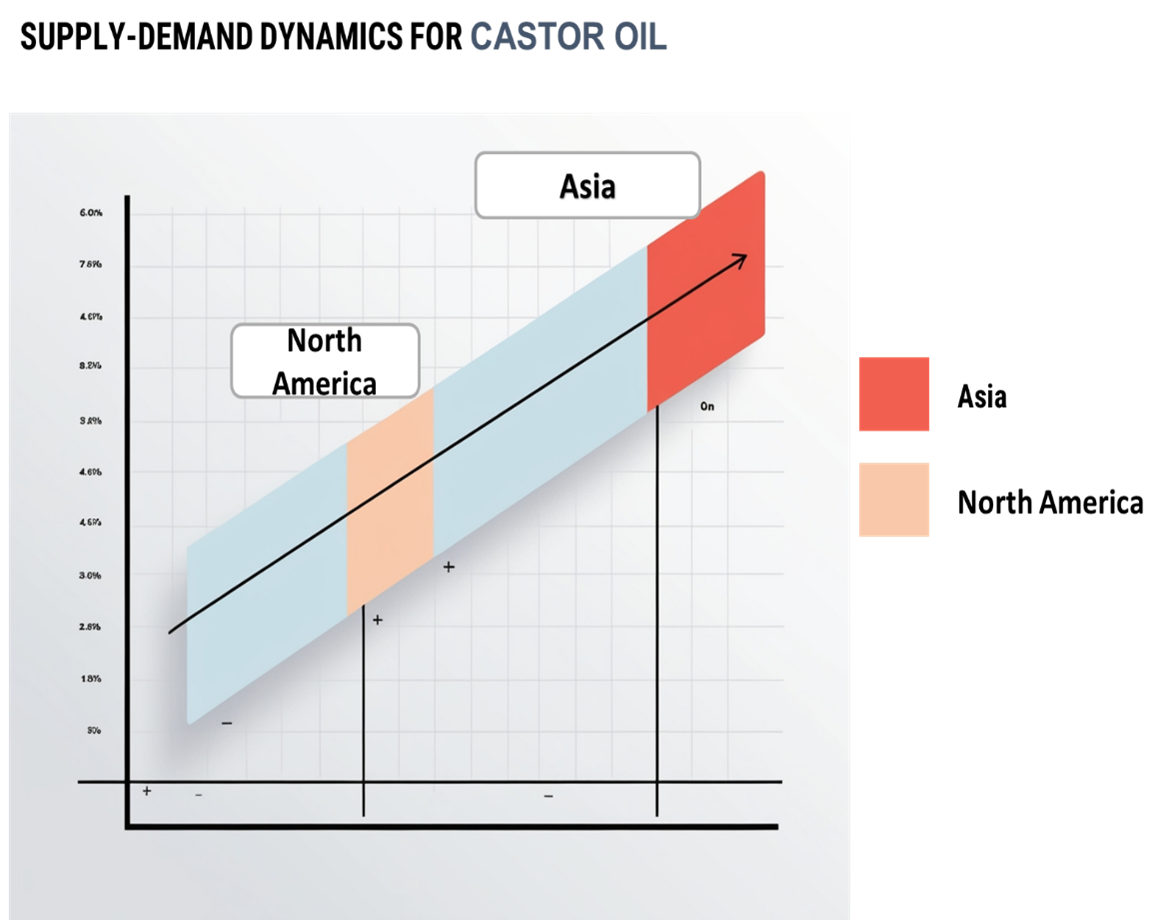
The image shows growing demand for Castor oil in both North America and Asia, with potential price increases and increased competition.
Asia-Pacific: A Key Region in the Castor Oil Market Asia-Pacific, particularly India, plays a dominant role in the global castor oil market due to the following factors:
-
Leading Producer: India accounts for over 70% of global castor oil production, making it the world's largest supplier. The country's favourable climate and large-scale farming ensure a steady supply to meet global demand. -
Strong Export Market: India exports a significant portion of its castor oil to regions including North America, Europe, and other emerging markets. The growing demand from the biofuels and pharmaceutical sectors is boosting exports. -
Cost-Effective Production: The cost of production in India is relatively lower due to cheap labour and favourable farming conditions, which enhances its competitive pricing advantage in the global market. -
Sustainability and Organic Farming: Increasing adoption of sustainable farming practices in India, such as organic castor cultivation, supports long-term supply stability while addressing global environmental concerns. -
Growing Local Demand: Domestic consumption in India is also increasing, particularly for use in cosmetics, pharmaceuticals, and industrial applications, further supporting regional demand.
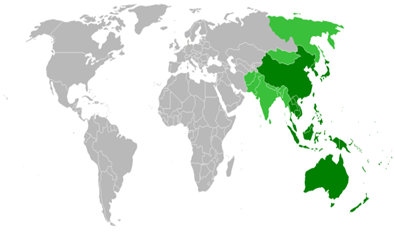
Asia Pacific remains a key hub Castor oil market and its growth
Supplier Landscape: Supplier Negotiations and Strategies in the Castor Oil Market
The Castor Oil market is characterized by a diverse and competitive supplier landscape, consisting of both global and regional players who provide critical raw materials, technology, and services essential for castor oil production. These suppliers contribute to the overall efficiency and sustainability of castor oil cultivation, processing, and distribution. Strong relationships between castor oil producers and their suppliers are critical to ensuring a consistent supply of high-quality castor oil, meeting the growing demand in industries like pharmaceuticals, cosmetics, and biofuels.
Some key raw material suppliers in the castor oil market include:
- Jayant Agro-Organics Ltd.
- RPK Agrotech
- The Andhra Sugars Limited
- Nandan Group
- Hokoku Corporation
- Adani Wilmar Limited
- Kandla Oil Refinery
- Castor Oil Industries (India) Ltd.
- Morrison & Foerster LLP
- BASF SE

Key Developments: Procurement Category Significant Developments
Development Area |
Description |
Impact |
Sustainable Farming Practices |
Adoption of sustainable farming practices and organic certification for castor seeds to improve environmental impact and meet consumer demand for eco-friendly products. |
Enhanced market appeal and long-term sustainability. |
Technological Advancements |
Innovation in processing techniques, such as cold pressing, to preserve the oil's quality and increase production efficiency. |
Improved oil quality and reduced production costs. |
Strategic Partnerships |
Growing partnerships between suppliers, farmers, and processors for stable raw material supply and product development in pharmaceuticals, cosmetics, and biofuels. |
Strengthened supply chains and diversified product applications. |
Regulatory Compliance |
Implementation of stricter regulations on castor oil production (e.g., safety standards and certifications for biofuels and cosmetics). |
Ensures product quality and broadens market access. |
Procurement Attribute/Metric |
Details |
Market Sizing |
The global castor oil market is projected to grow to USD 1.68 billion by 2032, with a CAGR of 5.3%. |
Adoption of Castor Oil-Based Products |
Increasing use of castor oil in pharmaceuticals, cosmetics, and biofuels is driving demand, with eco-friendly and organic products gaining popularity. |
Top Strategies for 2024 |
Focus on sustainable sourcing, expanding applications in biofuels, and enhancing processing technology to improve yield and quality. |
Automation in Castor Oil Processing |
Over 35% of castor oil production facilities are adopting automated oil extraction and refining technologies to boost efficiency and reduce waste. |
Procurement Challenges |
Key challenges include volatile raw material prices, fluctuating global demand, and risks related to climate change affecting castor plant yields. |
Key Suppliers |
Major suppliers include Jayant Agro-Organics, Maize Products, Adani Wilmar, and NK Proteins, focusing on diversified product offerings and regional supply chains. |
Key Regions Covered |
Major markets include Asia-Pacific (India, China), North America, and Europe, with significant production in India and increasing demand in Europe for industrial applications. |
Market Drivers and Trends |
Growth is driven by the increasing demand for castor oil in biofuels, cosmetics, pharmaceuticals, and natural product formulations. |

